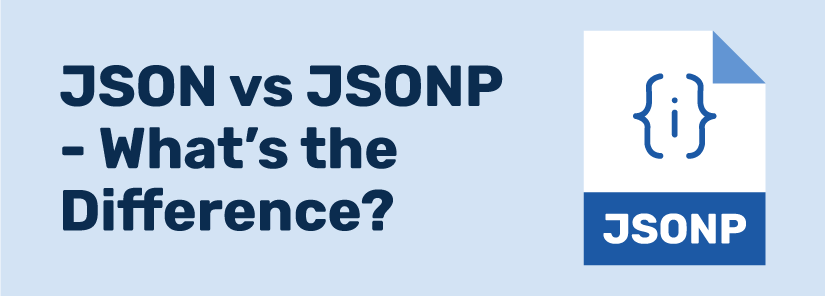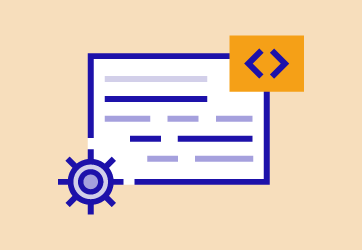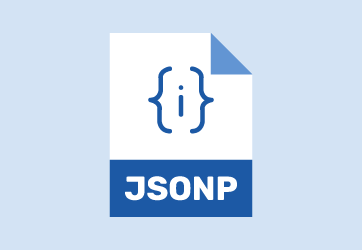JSON vs. JSONP – What’s the Difference?


The immense popularity of digital platforms and web-based applications has derived programmers to invent new ways of engaging audiences towards their products. The web world has grown in a dramatic way within a short span. This has opened many doors for individuals to grow and establish their business without going through traditional procedures. However, as a programmer, if you want to design a useful system, you must have a collection of useful tools in your bag that can help you in developing a unique and inspiring application. Also, a strong grip on the programming languages and the right selection of PL for designing a system is vital in this procedure.
JSON is considered one of the most useful and efficient ways for transmitting data between a server and clients. This format has cast away many conventional formats like XML and made a prominent place in no time. However, there are many limitations you may face in JSON. To overcome these limitations, the use of JSONP is highly suggested as this format has been appreciated by programmers all over the globe.
In this post, we are going to elaborate on a few vital differences between JSON and JSONP for your better understanding. Let’s begin with having an eye on the working of JSON format first.
Understanding JSON (JavaScript Object Notation)
JSON or JavaScript Object Notation is widely used for shifting data between server and client. You might have a question in your mind that XML also has the same purpose, then why would we use JSON? Well, undoubtedly, XML is also used for transferring information over the web, but there are many advantages that you will enjoy with JSON instead of XML. Some of them are as follows:
- JSON is light-weight as compared to XML.
- JavaScript Object Notation is an independent language.
- Simple to learn, read, and write.
- JSON is entirely text-based, which makes it a human-readable data exchange format.
JSON objects have a definitive syntax that makes developers’ job easy to read and write code, as they will have an idea of what they can expect from JSON. JavaScript Object Notation is light weighted; it becomes straightforward to load the requested data swiftly.
Also, this format is language-independent, so you can use it while working well with most of the modern programming languages. However, an issue arises when you want to share data among different domains. JSON isn’t a suitable option for this need. You can use JSONP to transmit data among different domains.
JSON Example
The following example will help you understand the schema of JSON code instantly.
{
“”:
[
{
“id”:”03″,
“language”:”JSON”
},
{
“id”:”05″,
“language”:”C++”
},
{
“id”:”09″,
“language”:”PHP”
}
]
}
Understanding JSONP (JavaScript Object Notation with Padding)
JSONP is the abbreviation of JavaScript Object Notation with Padding. If you are a JSON programmer, then you must be familiar with this that requesting a file from an alternative domain can cause problems due to cross-domain policy. But, you don’t feel any ambiguity with JSONP as this format allows you to request an external script from another domain.
The basic reason behind this difference is that JSONP requests files using the script tag instead of the XMLHttpRequest object. JSONP is a commanding technique for constructing mashups. When you use JSONP, you are basically adding up a script from a remote server in another domain.
JSONP Example
<script>
$(document). ready (function () {
$. ajax ({
url: 'http://abc.com/status/user_timeline/padraicb.json?count=5',
dataType: 'jsonp',
success: function(dataWeGotViaJsonp){
var htmlData = '';
var len = dataWeGotViaJsonp.length;
for(var i=0;i<len;i++){
twitterEntry = dataWeGotViaJsonp[i];
htmlData += '<p>
<img src = "' + abcEntry.user.profile_image_url_https +'"/>' + abcEntry['text'] + '</p>
'
}
$('#MyabcFeed').html(htmlData);
}
});
})
</script>
<div id="MyabcFeed">
</div>
Final Words
JSON has marked its place in the programming world in no time. The easy to learn structure, clear logic, and unambiguously readable context make this format highly useful for transmitting data between a server and clients. However, you might find it difficult when you want to transfer information from a domain to another domain. But, the use of JSONP will save you from making any hard efforts as this format allows you to transmit data between two different domains. The aforementioned information will be beneficial for you in getting familiar with the basics of JSON and JSONP formats. You can also go through the shared examples of both formats to understand their structures properly.
When you are working with JSON you might need multiple tools like JSON Formatter, JSON Viewer, String to JSON, JSON Validator. JSONONLINE.net has all the JSON tools that will help you while programming.
October 21, 2021

October 13, 2021




Leave a Reply